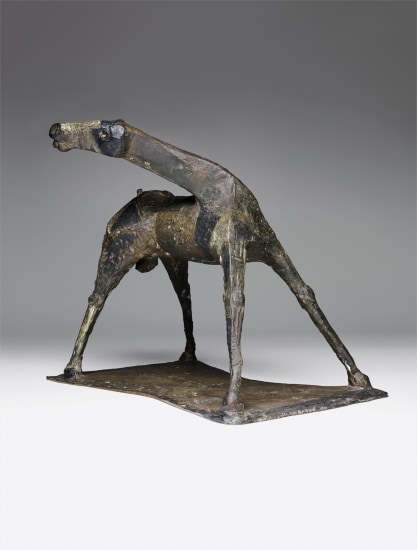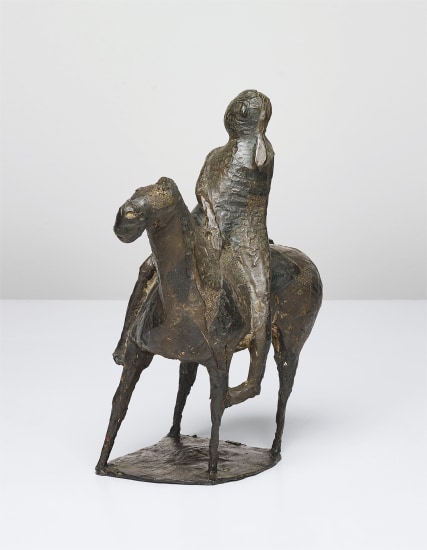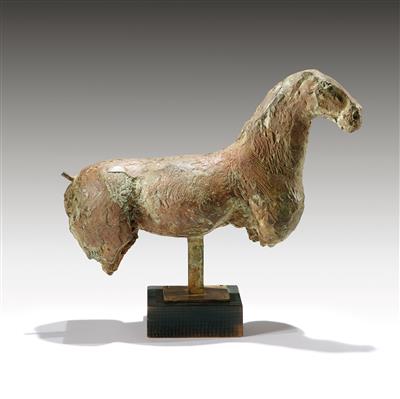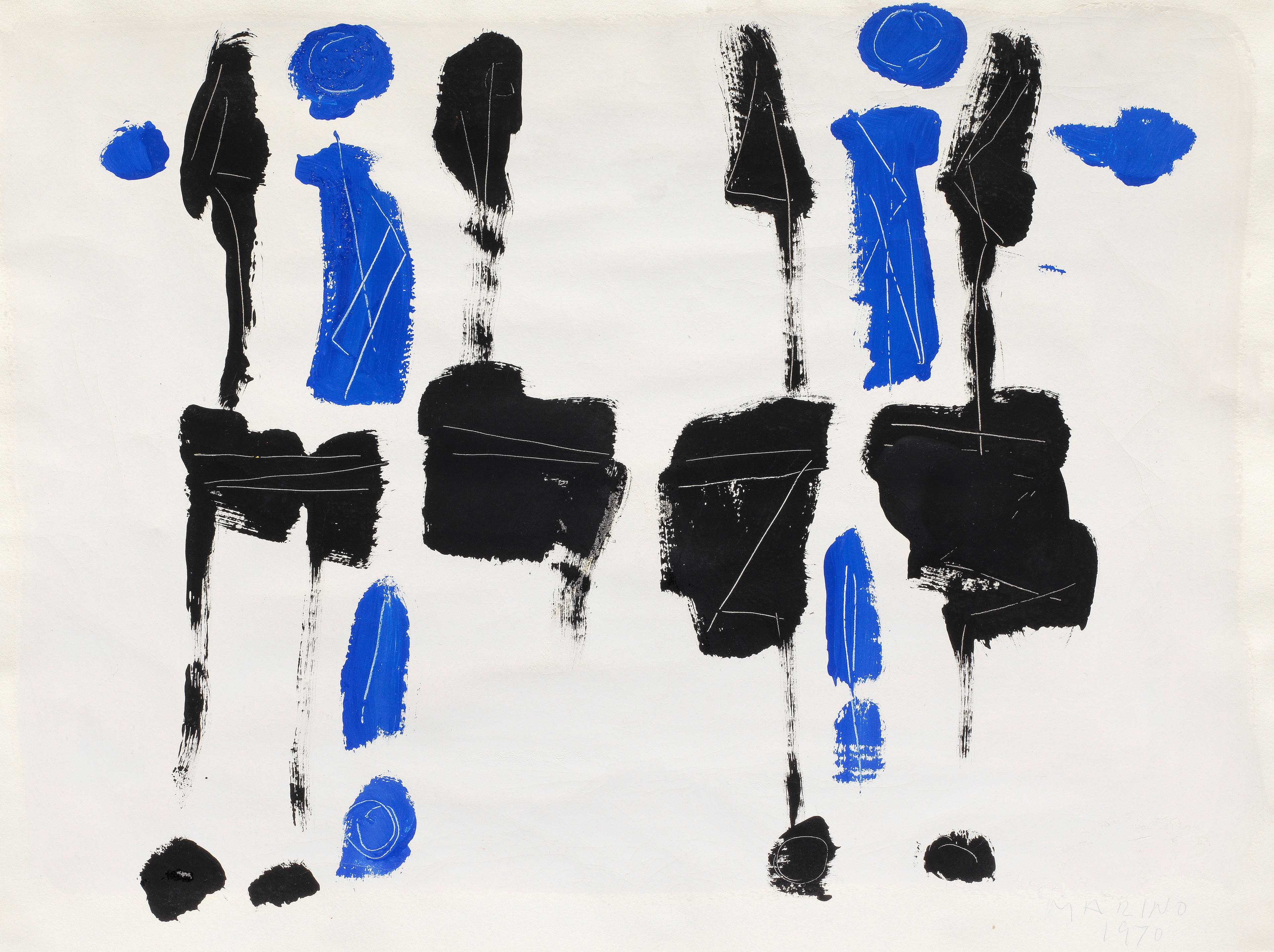Marino Marini Babilonia 1958 oil and mixed media on canvas 99.1 x 80.1 cm (39 x 31 1/2 in.) Signed 'Marino' on the reverse. This painting is recorded with the Marino Marini Foundation under archive number 346. This work is accompanied by a certificate of authenticity provided by the Marino Marini Foundation.
Provenance Mercedes Pedrazzini Marini, Milan Christie's, London, Impressionist/Modern Day Sale, 5 February 2009, lot 459 Acquired at the above sale by the present owner Exhibited Nurnberg, 1984, no. 16 Munich, Wien, 1984, no. 132 Rome, Villa Medici, Marino Marini Antologica 1919-1978, 1991 Chartes, Musee des Beaux-Arts de Chartes, Marino Marini Peintures, 1993, no. 44 Literature L. Papi, Marino Marini Paintings, Italy: Leslie J. Sacks, 1989, no. 382, p. 200 (illustrated) Marino Marini Antologica 1919-1978, exh. cat., Villa Medici, Roma, 1991 M. Bazzini and M. Tosi, Marino Marini La forma del colore, Italy: M&M, 2001, no. 42, p. 74 (illustrated) R. San Lazzaro, Complete Works of Marino Marini Italy, 1970, no. 274, p. 229 (illustrated) Catalogue Essay Babilonia is a mid-career work by Tuscan painter and sculptor Marino Marini This painting is amongst the most emotional and powerful ever realized by the artist. Charged with a vibrant colour palette, the work depicts a horse and rider alongside a standing figure. The rider stretches his arms outwards in agony as the female figure reaches upwards towards the heavens. The torment and chaos of the figures and the red and crimson overall tonality of the composition is representative of the artist’s world view. Moreover, the layered brushstrokes and uneven texture of the work furthers these feelings of dismay and anxiety. After WWII, many modern artists had a pessimistic outlook of the world, and this generally morbid perspective is accented by the title of the piece. Babylon, throughout art history, has epitomized the confusion and chaos caused by godlessness. Before, his depictions of riders and horses were free and joyful, but after the war the artist explained that now his equestrian depictions 'expressed the torment caused by the events of this century’. ‘The restlessness of my horse grows with each new work, the rider appears increasingly worn out, he has lost his dominance over the beast and the catastrophes to which he succumbs are similar to those which destroyed Sodom and Pompeii' (R. Littlejohns, Myths of Europe, p. 243). The struggle between the rider and the horse is symbolic of the human condition in the aftermath of the WWII. The two figures can be seen as messengers or interpreters of history and the cold state of the human psyche at the time. This same symbol appears elsewhere, as in Fredich Dürremantt’s An Angel Comes to Babylon of 1953. Marini’s eschatological view on the destruction of language and the cataclysmic end of the world was shared by other artists such as Alberto Giacometti and Jean Fautrier who similarly express the pessimism, fear, and anxiety caused by the effects of WWII and the paralyzing notion of nuclear annihilation as the Cold War began to build up. Tied up in a visual language of chaos and torment, this work encompasses the psyche of an entire generation of artists who struggled to return to painting after the greatest war the world had ever seen, making it a critical, powerful, and seminal work within the oeuvre of Marini. Read More
Marino Marini Babilonia 1958 oil and mixed media on canvas 99.1 x 80.1 cm (39 x 31 1/2 in.) Signed 'Marino' on the reverse. This painting is recorded with the Marino Marini Foundation under archive number 346. This work is accompanied by a certificate of authenticity provided by the Marino Marini Foundation.
Provenance Mercedes Pedrazzini Marini, Milan Christie's, London, Impressionist/Modern Day Sale, 5 February 2009, lot 459 Acquired at the above sale by the present owner Exhibited Nurnberg, 1984, no. 16 Munich, Wien, 1984, no. 132 Rome, Villa Medici, Marino Marini Antologica 1919-1978, 1991 Chartes, Musee des Beaux-Arts de Chartes, Marino Marini Peintures, 1993, no. 44 Literature L. Papi, Marino Marini Paintings, Italy: Leslie J. Sacks, 1989, no. 382, p. 200 (illustrated) Marino Marini Antologica 1919-1978, exh. cat., Villa Medici, Roma, 1991 M. Bazzini and M. Tosi, Marino Marini La forma del colore, Italy: M&M, 2001, no. 42, p. 74 (illustrated) R. San Lazzaro, Complete Works of Marino Marini Italy, 1970, no. 274, p. 229 (illustrated) Catalogue Essay Babilonia is a mid-career work by Tuscan painter and sculptor Marino Marini This painting is amongst the most emotional and powerful ever realized by the artist. Charged with a vibrant colour palette, the work depicts a horse and rider alongside a standing figure. The rider stretches his arms outwards in agony as the female figure reaches upwards towards the heavens. The torment and chaos of the figures and the red and crimson overall tonality of the composition is representative of the artist’s world view. Moreover, the layered brushstrokes and uneven texture of the work furthers these feelings of dismay and anxiety. After WWII, many modern artists had a pessimistic outlook of the world, and this generally morbid perspective is accented by the title of the piece. Babylon, throughout art history, has epitomized the confusion and chaos caused by godlessness. Before, his depictions of riders and horses were free and joyful, but after the war the artist explained that now his equestrian depictions 'expressed the torment caused by the events of this century’. ‘The restlessness of my horse grows with each new work, the rider appears increasingly worn out, he has lost his dominance over the beast and the catastrophes to which he succumbs are similar to those which destroyed Sodom and Pompeii' (R. Littlejohns, Myths of Europe, p. 243). The struggle between the rider and the horse is symbolic of the human condition in the aftermath of the WWII. The two figures can be seen as messengers or interpreters of history and the cold state of the human psyche at the time. This same symbol appears elsewhere, as in Fredich Dürremantt’s An Angel Comes to Babylon of 1953. Marini’s eschatological view on the destruction of language and the cataclysmic end of the world was shared by other artists such as Alberto Giacometti and Jean Fautrier who similarly express the pessimism, fear, and anxiety caused by the effects of WWII and the paralyzing notion of nuclear annihilation as the Cold War began to build up. Tied up in a visual language of chaos and torment, this work encompasses the psyche of an entire generation of artists who struggled to return to painting after the greatest war the world had ever seen, making it a critical, powerful, and seminal work within the oeuvre of Marini. Read More






.jpg)

.jpg)
.jpg)
.jpg)



Try LotSearch and its premium features for 7 days - without any costs!
Be notified automatically about new items in upcoming auctions.
Create an alert